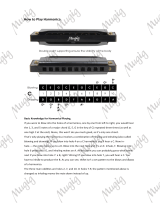Page is loading ...


The Melodica, also known as the Wind Piano can be
described as a free reed system with a mouthpiece,
air chamber, and keyboard. The Melodica sounds
very much like a keyboard harmonica (although it is
a tad more dicult to bend notes on it as you are
further from the reeds) and it produces sound only
exhaling into not inhaling. When playing more than
one note at a time (polyphonic) the Melodica can
sound very reminiscent of an accordion. Aside from
these two analogies the instrument has an identity
of its own.
How to hold the instrument:
How to play:
The two main concepts to be addressed when
approaching the melodica are hand technique &
breath control. Like singing it may be easier to play if
you are standing. For smooth passages (legato) use
the “breath mode”, namely breathe air into the
Hold the melodica with the left
hand as these are right handed
instruments. Place hand between
the instrument and the handle.
Press lips around the mouthpiece,
ensuring that all sides are closed.
Stay relaxed and experiment with
what feels & sounds right. Many
melodicas come with a ex tube
allowing you move, play, and see
the instrument at dierent angles.
Place the melodica & ex tube on
the piano and play with one hand
on each instrument.

instrument. For heavier passages use the palate
attack, using air as in whistling either more or less, as
required. The tongue can be used for short and
precise note values (staccato). In this way suitable
articulation for all kinds of playing will develop.
Quickly vary your breath to create tremolo (change
in volume). This is the melodicas version of vibrato
(change in pitch).
Caution: A fast intense burst of air can knock your
reed out of alignment. Think of it as blowing into a
balloon. The harder/faster you blow the louder your
keyboard will sound.
The more notes you play at the same time the softer
the instrument may sound as you are displacing air
thru more reeds. Experiment.
Bending notes
While holding down a key and blowing steadily,
slowly lift your nger allowing the key to rise (so it is
at the point where the air ow is incomplete or
choking the reed). At this time you will hear the pitch
drop. A technique can be developed where by
playing pressing the keys half way down while
blowing, this Bending of notes will occur.
Next, address the instruments keyboard. There are
few books out on how to play the melodica. Some
people will naturally just begin to listen, play & nd
melodies, and via trial and error begin to put
together a style. If you are just starting out and have
never played a keyboard before we recommend
acquiring a basic piano book of scales and the

appropriate ngering. This is necessary regardless if
you plan to read music or not. It is a great system for
exposing yourself to dierent keys and developing a
hand system for passing the thumb under the ngers
allowing you to play longer phrases (sentences).
Care of the melodica:
When not in use keep the instrument in its box to
protect it from dust, dirt and children. Make sure the
box is vented to minimize condensation. Cold
temperature also aects the smooth working of the
reeds, so let the instrument warm up to room
temperature before playing. Playing a melodica that
is cooler than room temperature will put condensa-
tion on the reeds.
Caution: Do not leave a melodica in hot car during
summer. Temps above 90 degrees may reduce your
wind piano to a warp piano (distant unplayable
relative).
Periodically open the moisture vent located on end
of melodica opposite the mouthpiece, by pressing
the button especially immediately after playing, and
blow through the instrument without pressing any
of the keys or hold melodica vertically and shake up
and down. This will remove most condensation
which may have collected. Shake the ex tube to
expel moisture. From time to time these instruments
like their cousins the harmonica/accordion/organ
require some reeds to be tuned.
/



